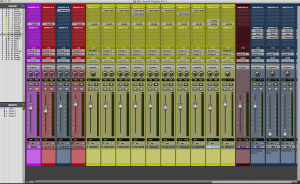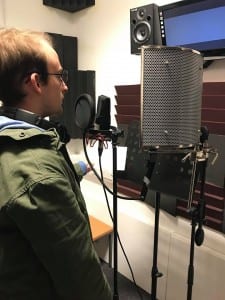LO2: Create audio material for film makers through professional collaboration.
LO3: Apply professional Pro-Tools editing and mixing techniques in a Audio Post Production situation for a film project.
The post production for A Christmas Proposal proved to be quite a long winded edit. Although a lot of the recordings were very crisp and clear, there were multiple issues with the kitchen scene. This was due to the fact we were running short on time and the director insisted we did it in one take just so we had it. We did make it clear with the director that there was a lawn mower that was audible no matter where we positioned our boom microphones and he was fine with it due to the fact he wanted to get something recorded, no matter how bad the quality.
Due to research, I was able to know what file to ask the editor to export in, an OMF. After receiving the project, the first call of action was to separate all the dialogue into character specific tracks, this allowed me to edit aspects of the characters voices accordingly such as making Angus’s voice less boomy/basey. This was done as the direction mentioned it when we initially handed over the project. We also did this, so that we could layer in our own atmos tracks. This all together created an edit where we able to control all independent aspects. This was bought up as a positive step within 344audio’s comprehensive guide to audio post production in which they argued that the most individual aspects that are separate, the more control you will have over the final mix.
Once everything was separated and ready, I would refer back to SoundTracks 12 step guide for my work flow. A scene we specifically had issues with was the kitchen scene. The first initial idea I had to separate the dialogue and label it under track titles such as “Angus: Kitchen Dialogue”. The idea would be to work on all the dialogue tracks separately, going through each and attempting to remove the lawn mower sound. The idea was then to place our own kitchen dialogue in to fill the gaps. A massive issue we discovered early on though is that the room sound was incredibly inconsistent. Taking into consideration research from Bobby Owinski’s Mixing Engineers Handbook, I gauged that a better approach would be to apply the same EQ, de-essers and d-verb plug in settings to the whole scene, this immediately resulted in a more consistent room sound whilst also allowing us to control individual elements such as dialogue volume for each character.
In general we had quite clean takes, however I still decided it would be a positive step to attempt to clean up dialogue in the sense of removing unwanted hums and fuzz. To do this, the vast majority of dialogue tracks feature a 7 band EQ that sweeps the low end frequencies. This was done due to a recommendation within Jay Rose’s text within a chapter entitled “Dialogue editing”.
The final step taken was mixing every element in, for this; I following Bobby Owinski’s advise into a final mix. Following the order of; dialogue, atmospheres, sound effects and finally music.

